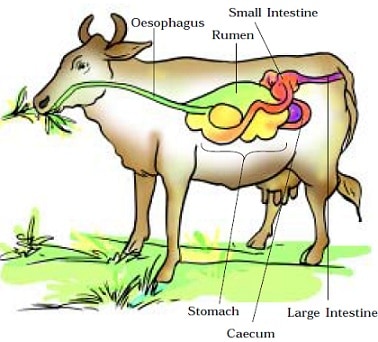
Role of Ruminant Stomach in Digestion of Food in the Production of Milk
What is Ruminant?
Dairy animals like cattle, buffaloes, sheep, goats, and camels are herbivores because their diets are composed primarily of plant material. Many herbivores also are ruminants. Ruminants can be recognized easily because they chew frequently even when not eating. This process of taking food back into the mouth, rechewing, remastication & regurgitation is called rumination. The present article discusses what is a ruminant, ruminant digestive system of the animal stomach indigestion of food/protein in milk production. The following are basic differential points between ruminants & Non-Ruminants.
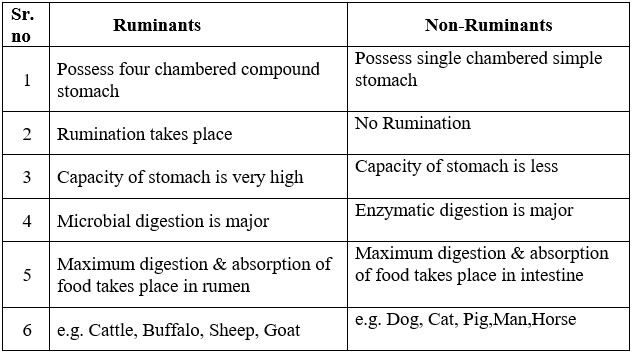
Anatomy & Physiology of Ruminant Stomach
The stomach of the ruminant occupies nearly three fourth of the abdominal cavity and it is divided into four-compartment viz. rumen, reticulum, omasum, and abomasum. In the young suckling calf, the first three compartments are poorly developed (fig.1) and milk flow reaches directly to the abomasum. Hence in a young calf (Birth to 3 wks), The abomasum is the major functional department. As the calf starts eating solid foods the Rumen & Reticulum enlarge greatly and ultimately in adult age they assume 85% of the total stomach.
Ruminant Stomach: It is also known as a compound four-chambered stomach. The first 3 compartments are collectively called a forestomach while the fourth compartment, abomasum is called a True stomach. The average capacity of the stomach in adult cattle ranges from 100-230 liters depending upon the size of the animal.
The structures of ruminant stomach parts along with their uses are described below
Rumen:
- It is the first and the largest compartment which covers about 70-80% portion of the ruminant stomach.
- It is situated on the left side of the abdominal cavity.
- It is a Turkish towel like appearance on the inner side
- It communicates with esophagus anteriorly & reticulum posteriorly
Functions:
a) Storage of food
b) Proper mixing of ingesta
c) Microbial digestion of protein, fats, and carbohydrates
d) Vitamin synthesis
e) Absorption of volatile fatty acids
f) Expulsion of gases like C02 and Methane
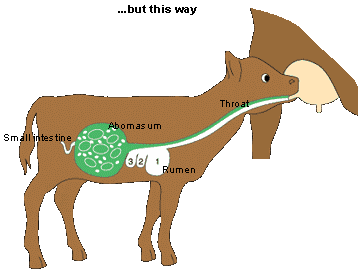
Digestive System of Ruminant
Reticulum:
i) It is 2nd and smallest compartment of the ruminant stomach
ii) It forms approximately a 5% portion of the stomach.
iii) It is a honeycomb-like appearance on the inner side
iv) It communicates with rumen anteriorly & omasum posteriorly
Functions:
a) It separates foreign objects like a nail, stone, wire from ingested food
b) It acts as a filter for food material
c) It helps in regurgitation
Omasum:
i) It is the 3rd compartment of the ruminant stomach.
ii) It forms approximately 7-8% portion & located on the right side of the abdominal cavity
iii) It communicates anteriorly with reticulum & posteriorly with abomasum.
Functions:
a) It removes 50% of the water from ingested food material
b) It absorbs volatile fatty acids
c) It also grinds course feed particles.
Abomasum:
i) It is 4th compartment of the ruminant stomach
ii) It is also called the true stomach of a ruminant.
iii) It forms approximately 7-8% portion & situated on the floor of the abdominal cavity
iv) It communicates anteriorly with Omasum & posteriorly with duodenum (Small intestine).
Functions:
a) Passing food from omasum to small intestine.
b) Digestion of Microbial protein b) Absorption of volatile fatty acids.
Different Steps in the Digestive System of Ruminant
The mechanism of ruminant digestion can be satisfactorily described as follows figure.
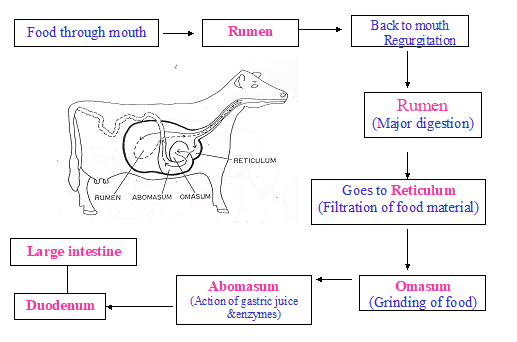
Important features in Ruminant Stomach
- Ruminant & Microbes: Ruminants & microbes are having true synergism means they help each other.
- Rumen to Microbes: Rumen provides an anaerobic environment, constant temperature, pH & nutrient for anaerobic bacteria, Bacteria and protozoa to grow & multiply. In the rumen, environment pH is maintained at 6.5-7.2 & temperature 39-400
- Microbes to Rumen: Microbes in rumen help in microbial digestion of feed, which results in cellulose degradation, production of volatile fatty acids & microbial proteins.
- Activities taking place in Rumen: i) Mixing of feed ii) Rumination iii) Carbohydrate fermentation iv) Microbial digestion v) Protein synthesis vi) Vitamin synthesis
How microbial digestion takes place in the rumen?
Microbial digestion means the breakdown of food in the rumen is brought about by bacteria and protozoa. Microbes in rumen undergo fermentation process & help in degradation of feed to obtain byproducts of digestion.
Rumen provides a favorable site for digestion of Carbohydrates, Protein & Fats.
a) Digestion of Carbohydrate:
In the rumen, the carbohydrate components of the diet like cellulose, hemicellulose, starches, sugars are converted to volatile fatty acids i.e. Acetic acid, Propionic acid, and Butyric acid along with the production of gases like Methane & Carbon dioxide. These volatile fatty acids are absorbed through the ruminal wall and the gases are eructed through the mouth during rumination.
Lactic acid is also produced in rumen after switching of diet from a high fiber to high concentrates that is rich in fermentable carbohydrates (starches and sugars). The production is due to lactic acid utilizing bacteria like Streptococcus Bovis, Lactobacillus acidophilus. Though lactic acid produced not directly linked with milk production sometimes Propionic acid helps in the synthesis of lactose. Excess lactic acid production may cause subacute or acute ruminal acidosis.
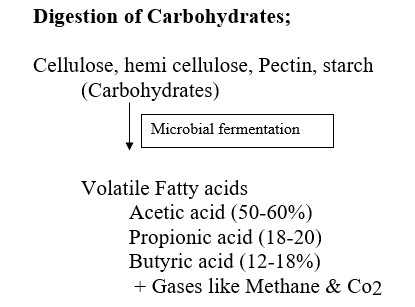
b) Digestion of Protein:
The dietary protein that is directly available to cow may be of Rumen degradable protein (RDP) and Rumen undegradable protein (RUP or Bypass).
- RDP or Microbial protein: Rumen microbes breakdown degradable protein to small peptides, amino acids, and ammonia. These products can in turn used by rumen microbes to produce microbial proteins that can be digested by a cow in the small intestine. Microbial protein is excellent quality protein, unfortunately not enough can be produced to supply the requirement for the high producing dairy animal. Therefore, undegradable protein must be available to make up the difference between what the dairy cow requires and what microbial protein supplies.
- RUP or Bypass proteins: Bypass protein is a commonly used term to refer to a dietary protein that is not degraded in the rumen or proteins formed without microbial fermentation. These proteins escape degradation by rumen microbes & flows to abomasums & hydrolyzed to amino acids which get absorbed through the wall of the small intestine into the blood. In high producing dairy animals feeding of bypass, proteins are beneficial when animals requirement of proteins/amino acids is not being met. Both Rumen degradable protein (RDP) and Rumen undegradable protein (RUP or Bypass) are important to fulfill the requirement of protein in dairy animals.
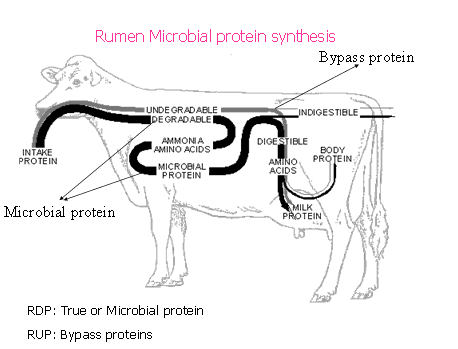
c) Digestion of Fats:
Fats are a source of energy for dairy animals. The common sources of fats are oilseed like sunflower, linseed, and cottonseed. Rumen microbes cause hydrogenation of fats.
Fats/Triglycerides are converted to glycerol and galactose, which in turn are converted to volatile fatty acids (VFA) by microbial enzymes.
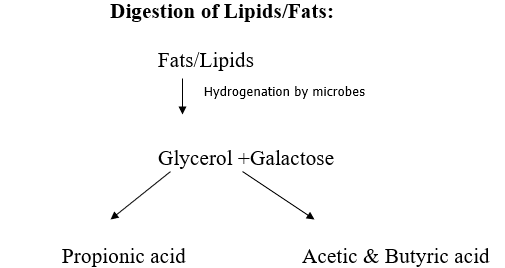
In this way, microbial digestion takes place in ruminants which results in the production of Volatile fatty acids, Microbial protein, Fat, Glucose.
Role of Rumen in the digestion of food for the production of milk
Dairy animals (Cows & Buffaloes) are the best converters of plant food into human food in terms of milk. This conversion is possible only by undergoing the process of the digestive system of a ruminant. The digested feed is absorbed in the body & utilized for body growth, maintenance & milk production.
All feed consumed by the animal undergoes a process of microbial fermentation & ruminant digestion which results in the production of Volatile fatty acids, Microbial protein, Lipids, Glucose. These all nutrients obtained help in the synthesis of Milk glucose (Lactose), Milk Protein (Casein) & Milkfat. Hence Ruminant digestion plays an important vital role in the digestion of feed for the production of milk.
Dr. Vijay Muley
Vetoquinol India Animal Health Private Limited, Mumbai
